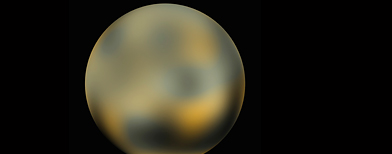
Spurned Pluto is changing its looks, donning more rouge in its complexion and altering its iceball surface here and there.
Color astronomers surprised.
Newly released Hubble Space Telescope photos show the distant one-time planet — demoted to "dwarf planet" status in 2006 — is changing color and its ice sheets are shifting.
The photos, released by NASA Thursday, paint a Pluto that is significantly redder than it had been for the past several decades. To the layman, it has a yellow-orange hue, but astronomers say it has about 20 percent more red than it used to have.
The pictures show icy frozen nitrogen on Pluto's surface growing and shrinking, brightening in the north and darkening in the south. Astronomers say Pluto's surface is changing more than the surfaces of other bodies in the solar system. That's unexpected because a season lasts 120 years in some regions of Pluto.
"It's a little bit of a surprise to see these changes happening so big and so fast," said astronomer Marc Buie of the Southwest Research Institute in Boulder, Colo. "This is unprecedented."
From 1954 to 2000, Pluto didn't change in color when it was photographed from Earth. But after that, it did. The red levels increased by 20 percent, maybe up to 30 percent, and stabilized from about 2000 to 2002, Buie said. It's not as red as Mars, however, Buie said.
Buie said he can explain the redness, but not why it changed so dramatically and so recently. The planet has a lot of methane, which contains carbon and hydrogen atoms. The hydrogen gets stripped off by solar winds and other factors, leaving carbon-rich areas on the surface, which tend to be red and dark.
The Hubble photos were taken in 2002 and the analysis took a few years. But why Pluto changed so quickly was such a mystery that Buie held off for years on announcing what he had found, worried that he might be wrong. However, since Pluto's moon Charon hadn't changed color in the same telescope images, he decided the Pluto findings weren't an instrument mistake.
His analysis also found that nitrogen ice was shifting in size and density in surprising ways. It's horribly cold on Pluto with, paradoxically, the bright spots being the coldest at about -382 degrees Fahrenheit. Astronomers are still arguing about the temperatures of the warm dark spots, which Buie believes may be 30 degrees warmer than the darker areas.
Part of the difficulty in figuring out what is going on with Pluto is that it takes the dwarf planet 248 years to circle the sun, so astronomers don't know what conditions are like when it's is farthest from the sun. The last time Pluto was at its farthest point was in 1870, which was decades before Pluto was discovered. Unlike Earth, Pluto's four seasons aren't equal lengths of time.
Buie's explanation makes sense, said retired NASA astronomer Stephen Maran, co-author of a book on Pluto. "Pluto is interesting and poorly understood, whether it qualifies as a planet or not," he said.
This is a very good picture of pluto. The colors are simply beautiful.